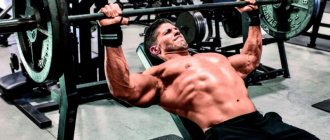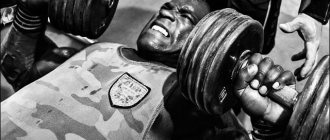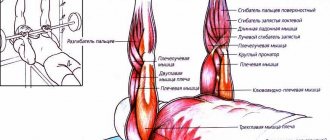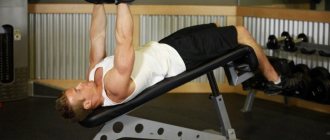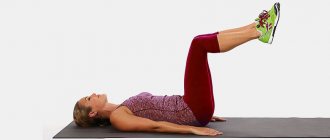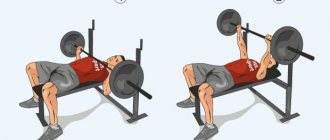Twists or incline crunches are the most common exercise in men's and women's programs. In addition, an inclined abdominal bench is present in any gym. The exercise is quite effective, but it also has its disadvantages and contraindications. It is important that many gym visitors, not realizing their mistakes, perform the exercise incorrectly, which later leads to serious back problems. Let's figure out how to avoid this and how to practice on an inclined bench correctly.
Pros and cons of incline crunches
Benefits and benefits of incline exercises:
- The presence of an inclination allows you to perform the exercise with greater amplitude with constant tension in the abdominal muscles. This increases the load on the abs, compared to crunches on the floor, in which the amplitude is shorter and the muscles relax in the lower position of the body.
- The presence of rollers for fixing the feet allows you to give all your best and load the muscles harder, without thinking about supporting your legs.
- Some types of benches are structurally designed to change the angle of inclination, thereby increasing or decreasing the load. Thus, the bench is suitable for both professionals and beginners.
- The simplicity and dimensions of the design allow you to install the exercise machine at home.
- The bench allows you to perform not only straight, but also oblique twists, more strongly involving the abdominal muscles in the work.
The disadvantage is possible back injury , since the bench does not allow you to determine the lower point of abduction of the body back, thereby inexperienced gym-goers often hyperextend their lower back and lean too far back.
And the main mistake is when lifting and deflecting is performed with a straight back. All these factors lead to back pain or worsening of existing problems.
Raising the torso on an incline bench
1) Lower and rise to the point that the abdominal muscles do not relax for a second and are constantly tense from the first to the last repetition;
2) When lowering, round your back so you relieve tension from the lower back;
3) When lifting your torso, you should not twist yourself completely; a clear example of incorrect execution is shown in Figure 2. The elbows should not reach the knees by about 10 cm, this allows you to always keep your abs tense.
4) When lifting, twisting even more tightly, tighten your abdominal muscles, or at the highest point of the lift, slightly straighten your back with your chin up (choose the option that will contract your abs the most);
5) Do not hold your breath, breathe deeply and correctly, inhale when relaxing, exhale when exerting effort.
6) The greater the inclination of the bench, the more difficult it is to perform the exercise, watch the technique, do not allow the body to rise through a jerk or push, only with the strength of the abdominal muscles.
7) Do not straighten your back when lifting, otherwise the lower back will be involved in the work, and the abs will lose the load, the back will be hunched as much as possible.
 There is no need to lower yourself onto the bench at the lowest point; leave your body suspended, not reaching the base 10-20 centimeters, in this case the abs will not relax and muscle failure will occur faster.
There is no need to lower yourself onto the bench at the lowest point; leave your body suspended, not reaching the base 10-20 centimeters, in this case the abs will not relax and muscle failure will occur faster.
9) During the exercise, hold your hands lightly near your temples and cross them over your chest; if you are a beginner and the exercises are difficult, hold on to the edges of the bench and help yourself slightly with your hands; as soon as your abs get stronger, helping with your hands is excluded.
What types of crunch benches are there?
- Adjustable – a universal option in which you can set the required inclination angle for crunches or use it as a horizontal bench for bench presses and many other exercises.
- Inclined - these benches are not adjustable and already have a certain preset angle of inclination. This machine can only perform straight or oblique crunches.
- Roman chair - can include the function of a bench for the press, but also makes it possible to perform hyperextension - extension of the torso. Read more about the Roman chair →
- With a curved bench - manufacturers of exercise equipment position the product as safe equipment for back problems, which supposedly allows you to get less stress and get rid of pain in the lumbar region. But this is a very controversial issue, because twisting on a bench does not involve complete lowering, much less hyperextension of the spine, which is completely contraindicated during twisting.
- Folding ones are exercise machines that can be folded, which makes them easy to use at home.
Description[edit | edit code]
Twisting with body raise on an inclined bench
Twisting with body lifting
As you exhale, slowly bend your upper torso. To complete this movement, bend your torso at the waist, tilting it towards your knees. Hold for a while and then slowly return to the starting position and repeat the exercise.
Initial position
- Lie on a bench inclined at an angle of 15-30 degrees, bend your knees and place your entire foot on the bench.
- Place your hands behind your head without clasping your fingers.
- Place your cervical spine in a neutral position.
- Activate your abdominal muscles.
Recommendations for implementation
- When performing crunches on an incline bench, do not use inertial force. Movements should be slow and controlled.
- The tailbone should be pressed tightly against the bench.
- Don't bend your neck too much or try to reach your chin to your chest. The head should maintain a neutral position in relation to the cervical spine.
- Do not help yourself with your hands when bending your torso. The movement should be accomplished by activating and isolating the abdominal muscles.
- Don't roll your shoulders in front. The chest should be straightened and the shoulder blades should be lowered.
- Exhale as you lift your torso, and inhale when returning to the starting position.
Main muscles involved during incline crunches
| Phase 1 | Phase 2 |
| Neck: sternocleidomastoid muscle Shoulder: serratus anterior, rhomboids, lower trapezius. | Torso: rectus abdominis, obliques. Neck: sternocleidomastoid muscle. |
Movement analysis[edit | edit code]
| Phase 1. Twisting | Phase 2. Lifting the body | |
| Major joints | Spine | Hip |
| Movements performed in the joints | Upward movement: flexion. Downward movement: extension. | Upward movement: flexion. Downward movement: extension. |
| Main muscles involved in movements | Rectus abdominis, obliques | Iliopsoas muscle, rectus femoris muscle |
Incline crunch technique
- Place your feet under special bolsters to secure the knee and ankle joints. Your thighs and buttocks should be in full contact with the incline bench.
- Put your hands behind your head or hold them on your chest - this will simplify the load.
- Round your back at the top of the movement and do not straighten your spine until the end of the approach.
- As you inhale, move your torso back, maintaining tension in your abdominal muscles, and lower until the angle between your torso and hips is approximately 90 degrees. Do not lower your back onto the bench, remember the tension in the abdominal muscles and rounding the spine .
- As you exhale, curl your abs, bringing your stomach toward your hips, but do not straighten your back.
Correct technique
Sit on a bench with a downward inclination, secure your legs under special bolsters, inhaling and slightly relaxing your abdominal muscles, lower your body down, do not allow your shoulder blades to fall completely onto the bench, leaving the distance between your shoulder blades and the bench is approximately 20-30 cm.
After this, exhaling exclusively with the strength of your abdominal muscles, lift your body up, additionally straining your abdominal muscles. To additionally work out the side of the press, alternately rotate the body at the top.
You can’t do it as shown in the figure; at the top point, due to the strong lifting of the torso, the load on the abdominal muscles is removed; by relaxing it, you reduce the effectiveness of the exercise.
Oblique crunches on a bench
Crunches are aimed at increasing the contraction of the external oblique abdominal muscles, but this does not mean that the rectus abdominis muscle works less.
- Place your feet under the support cushions.
- Place your hands behind your head and round your back.
- As you inhale, lean back, without straightening your lower back, to approximately a right angle between your hips and torso.
- As you exhale, begin to twist and from the middle of the amplitude, turn your body diagonally, aiming your right elbow towards your left knee, but do not straighten your spine, constantly keep your back rounded .
- As you inhale, in reverse order, slowly lean back to the bottom point of the movement with your torso level.
- Exhale and twist diagonally in the opposite direction.
- And while inhaling, return back to the lowest point. Perform the same number of repetitions on both sides.
Mistakes when doing incline crunches
Of course, mistakes are mainly made by novice athletes, and most often this relates to the position of the hands during the movement.
If you want to hold your hands behind your head, then they should be located in the ear area. If you clasp your fingers together and hold your farts behind your head, you may pull your neck muscles during the exercise. It is important to ensure that your chest is straightened while working. If your back is rounded, your risk of back injury increases significantly. When the body moves up, many athletes help themselves with their legs. This cannot be done, because it significantly reduces the effectiveness of twisting. Remember, all movements should be performed only using the strength of the target muscles, in this case the abs. To make your work a little easier, try to direct your gaze forward.
Recommendations for Bench Crunches
It's best to do abdominal exercises at the end of your workout. To maximally work your abdominal muscles, perform both variations of crunches on a bench, diluting them with leg raises on a horizontal bench or on the floor. For maximum effect, perform 20-30 repetitions in 3-4 sets.
After getting used to the load, the stronger sex can additionally use weights in the form of a plate, dumbbells or medicine ball. The number of repetitions varies between 15-25, and so on for 3-4 approaches.
Other types of incline crunches
Oblique crunches
The technique for performing this movement does not differ significantly from the classic version.
You only need to turn the body to the side when you reach the upper final position of the trajectory. But let's talk about this movement in a little more detail. After you have assumed a lying position on an inclined bench, you need to place your bottom hand behind your head and rest the other on your thigh. When you have reached the final position of the trajectory, rotate your body in the direction opposite to the arm placed behind your head. If your right hand is on the back of your head, then you need to turn to the left and touch your left knee with the elbow joint of your hand. Perform the specified number of repetitions, after which you need to change the direction of rotation of the body.
Reverse crunches
When performing this type of crunch, you need to lift your legs, not your body.
You need to take a lying position on an inclined bench, but in the opposite direction - grab the rollers for attaching your legs with your hands. With your legs slightly bent at the knee joints, begin to slowly lift them until your knees touch your chest. It is necessary to pay sufficient attention to working out the muscles. We have already said above that well-pumped abs will not only improve your appearance, but will also bring practical benefits. When working with free weights, almost all muscles of the body are involved in the movements, including the abs.
If your abdominal muscles are well developed, this will significantly reduce the load on the spinal column and thereby reduce the likelihood of injury. When working with a barbell, the abdominal muscles act as stabilizers.
When performing crunches on an incline bench, you do not need to use additional weights and your body weight will be enough. It is very important to master the technique of this movement well, since errors in its execution can lead to damage to the spinal column.
Although when performing crunches on an inclined bench, all the abdominal muscles are involved in the work, the majority of the load falls on the lower section of the group. Therefore, you should also do reverse crunches to get the most out of your abs. You should also remember the importance of warming up before starting the main sets.
Technique for performing crunches on an incline bench
Exercise technique
1. Lower the top edge of the bench at an angle of 30-40° to the horizontal. Sit on it and rest your shins on the bolsters.
2. Cross your arms over your chest and lower yourself back - your back, shoulders and head lie on the bench.
3. Inhale and hold your breath. Tighten your abdominal muscles and begin twisting - first your shoulders and head come off the bench, then your back.
4. Raise your torso solely through the efforts of your abdominal muscles. As soon as a right angle is formed between your torso and hips, freeze for a second and, exhaling, tighten your abs even more. Smoothly lower yourself to half the amplitude.
5. Do not relax your abs or touch the bench with your shoulders or head until the end of the set.
6. In the starting position, the gaze is directed to the ceiling, and during movement - always slightly above the crossed arms.
Incline Bench Crunches - Muscles
Muscle load
The incline crunch is an isolating load on the following muscles:
- Rectus abdominis muscle. The main emphasis is on her.
- Lateral abdominal muscles - work as core stabilizers;
- Oblique abdominal muscles – small static load. To increase it, you need to pull the body towards a separate leg. (In addition, there is a variation of our exercise - oblique twists).
- Core muscles. Train only with proper breathing.
- Quadriceps.
Yes, no matter how strange it may seem to anyone. At a high angle, the leg extensors work at full capacity. This happens due to the fact that the body wants to straighten up when twisting (natural resistance), which means it involves the legs, which try to straighten the metal roller. The load is very noticeable, although isolated.
Description of the exercise
Incline crunches are a basic abdominal exercise. It allows for many variations, varying in their impact and severity. This exercise is suitable both for the beginning of any workout (as a warm-up) and for the end.
Main features
1. The higher the inclination of the bench, the harder it is to do this exercise (all other things being equal).
2. Your task is to twist as much as possible (hunch your back) so that your abs work. If you rise with a straight back, it will not be the abs that will work, but the iliopsoas muscle.
3. You can either lower yourself completely onto the bench (while stretching your abs) or not lower yourself all the way. In the second case, the amplitude will be smaller. However, the abs will pound faster and harder.
4. You can use a barbell disc as a weight. You can place it either on your chest (easier option) or behind your head (more complicated option).
5. If you want the iliopsoas muscle to be disabled and only the abs to work, then do not lift your lower back off the bench at all. Just twist your back in the thoracic region. Although I don't see anything wrong with using extraneous muscles in this exercise.
6. If you still find it difficult to do this exercise, then cross your arms over your chest. Or grab the edges of the bench with your hands. It's easier.

